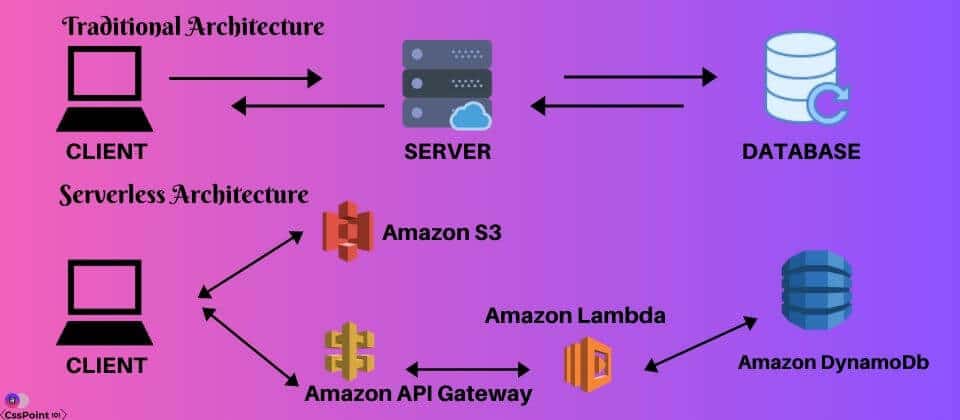Benefits Of Serverless Architecture over Client based Computing

For all web applications, communication will happen between the client and the server. This is the basic concept of networking.
The server will be receiving the request from the client, which is ideally the user here and the server will send a response to the request.
However, there are different types of web application architecture. In the time past, this process started with the help of hardware servers, which is client based architecture or server hardware architecture. Then it moved to cloud hosting and wireless servers.
Each time a new server technology is developed, there are always changes in the infrastructure and scalability factor but the reliability increases.
In the present scenario, serverless architecture seems to be the hype in the market, although there are some cons of serverless architecture.
Also, it does not mean that there are no servers present here. Since the components in the infrastructure will be in the distributed form instead of relying on or connecting to one single server, this architecture got the name serverless.
In this case, the serverless architecture framework has cost advantages since there are no commotions regarding the maintenance of the infrastructure and also to organize the set-up.
This is one of the main reasons people think serverless technology is better than server-based computing (SBC).
The Service Advantage of Serverless based Computing
In serverless architecture, the major advantage comes from the fact that the concept paves way for the function to be used as a service.
This allows the platform to be used for the code deployment when there are event-based functions to be done.
All these functions will be performed one by one when it is separately called.
In this way, it might seem like it acts like a microservice architecture, but since microservices will act like standalone business functions that work as separate services when implemented, it can not be compared to the serverless architecture.
In the serverless architecture, the distribution of functions will be running on different servers.
Additionally, this will allow the various third-party services to be part of the system.
For all the backend services, third-party services can be used here. This will allow the backend to be a service in the serverless architecture.
It will even help in reducing the effort put into development and it will also allow the creation of several applications in the backend architecture as the required materials are already present with the third-party services.
Cost Benefits of Serverless Architecture
Thinking of why serverless architecture is better for your business, the one other major benefit offered by serverless architecture is the reduction in cost.
In case you go for a hardware server, there is the main cost that will be incurred for the purchase of the hardware.
Then comes the organizing of the hardware and not to mention the never-ending maintenance cost incurred.
Apart from this, there are labor costs, which are involved with the installation and maintenance of the servers.
The other costs like the physical space for the labor, the electricity costs, etc will skyrocket in no time. All this will cost a lot of money.
By going with the serverless architecture, these costs can be avoided.
There will be the cost of the idle time in the virtual servers which can not be avoided in the serverless architecture.
Still, it will help in bringing down the infrastructure cost drastically, which can not be done with the traditional hardware server.
Though there are various servers present under the serverless architecture, it will only cost the same as one server in terms of electricity cost.
This paves way for the reduction in costs for the resources that are used.
On cost alone, there are many benefits of serverless architecture compared to server based.
Most tech companies now prefer going serverless and there are use cases that have proven to be cost-effective.
Serverless architecture is Practically expandable
One thing which the serverless architecture offers and that can not be competed with the other servers is the scalability factor.
In the traditional servers, there are certain limits up to which the computing can be done.
Even for this maximum utilization of the server, there are heavy computing techniques that are to be implied to keep the server going.
And there are a lot of times when the server is left idle because a peak is reached. But this is not a problem in the serverless architecture as the scaling is done in a horizontal manner.
There will be distributed use of resources which will help in keeping the cost to the minimum too.
This also paves way for an increase in resilience. Since the distributed functions occur, they all work individually.
So, even if one of the functions fails to operate it will not cause any kind of hindrance to the other functions.
With this advantage, the overall performance of all the functions can be maintained.
Serverless Architecture Saves Time
In the case of physical servers, one of the major concerns is the delay in time for response.
It will affect the performance of the systems heavily. This happens because of the location factor.
Since the servers are present in varied locations and can be quite distant, the delay in response increases.
In the case of serverless architecture framework, the problem of time delay is close to zero.
This is because, with the help of serverless architecture, one can achieve global coverage and the data centers will be able to reach at all times.
This will help in reducing the response time drastically.






